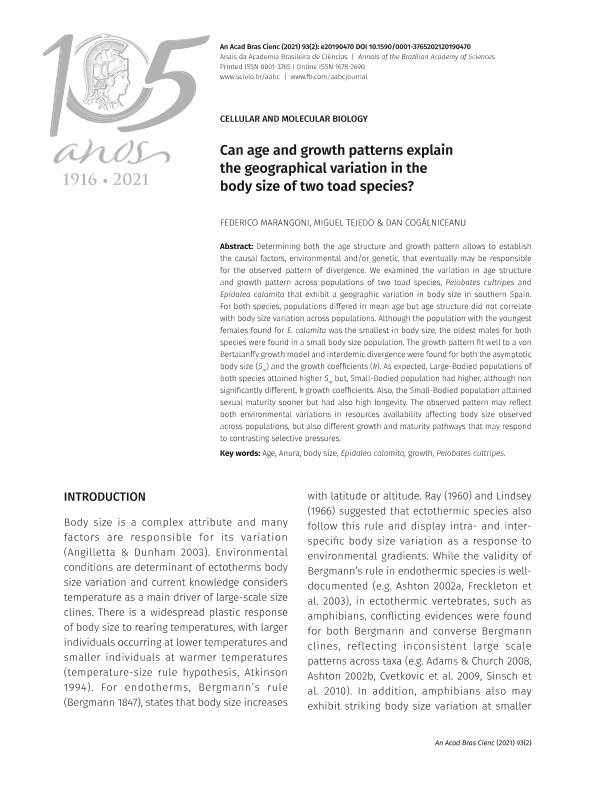Mostrar el registro sencillo del ítem
dc.contributor.author
Marangoni, Federico

dc.contributor.author
Tejedo, Miguel

dc.contributor.author
Cogalniceanu, Dan
dc.date.available
2021-08-03T14:58:57Z
dc.date.issued
2021-06
dc.identifier.citation
Marangoni, Federico; Tejedo, Miguel; Cogalniceanu, Dan; Can age and growth patterns explain the geographical variation in the body size of two toad species?; Academia Brasileira de Ciencias; Anais da Academia Brasileira de Ciencias; 93; 2; 6-2021; 1-19
dc.identifier.issn
0001-3765
dc.identifier.uri
http://hdl.handle.net/11336/137668
dc.description.abstract
Determining both the age structure and growth pattern allows to establish the causal factors, environmental and/or genetic, that eventually may be responsible for the observed pattern of divergence. We examined the variation in age structure and growth pattern across populations of two toad species, Pelobates cultripes and Epidalea calamita that exhibit a geographic variation in body size in southern Spain. For both species, populations differed in mean age but age structure did not correlate with body size variation across populations. Although the population with the youngest females found for E. calamita was the smallest in body size, the oldest males for both species were found in a small body size population. The growth pattern fit well to a von Bertalanffy growth model and interdemic divergence were found for both the asymptotic body size (Sm ) and the growth coefficients (k). As expected, Large-Bodied populations of both species attained higher Sm but, Small-Bodied population had higher, although non significantly different, k growth coefficients. Also, the Small-Bodied population attained sexual maturity sooner but had also high longevity. The observed pattern may reflect both environmental variations in resources availability affecting body size observed across populations, but also different growth and maturity pathways that may respond to contrasting selective pressures.
dc.format
application/pdf
dc.language.iso
eng
dc.publisher
Academia Brasileira de Ciencias

dc.rights
info:eu-repo/semantics/openAccess
dc.rights.uri
https://creativecommons.org/licenses/by/2.5/ar/
dc.subject
AGE
dc.subject
ANURA
dc.subject
BODY SIZE
dc.subject
EPIDALEA CALAMITA
dc.subject
GROWTH
dc.subject
PELOBATES CULTRIPES
dc.subject.classification
Ecología

dc.subject.classification
Ciencias Biológicas

dc.subject.classification
CIENCIAS NATURALES Y EXACTAS

dc.title
Can age and growth patterns explain the geographical variation in the body size of two toad species?
dc.type
info:eu-repo/semantics/article
dc.type
info:ar-repo/semantics/artículo
dc.type
info:eu-repo/semantics/publishedVersion
dc.date.updated
2021-07-30T18:51:26Z
dc.identifier.eissn
1678-2690
dc.journal.volume
93
dc.journal.number
2
dc.journal.pagination
1-19
dc.journal.pais
Brasil

dc.journal.ciudad
Rio de Janeiro
dc.description.fil
Fil: Marangoni, Federico. Universidad Nacional del Nordeste. Facultad de Ciencias Exactas, Naturales y Agrimensura. Departamento de Biología; Argentina. Consejo Nacional de Investigaciones Científicas y Técnicas. Centro Científico Tecnológico Conicet - Nordeste; Argentina
dc.description.fil
Fil: Tejedo, Miguel. Consejo Superior de Investigaciones Científicas; España
dc.description.fil
Fil: Cogalniceanu, Dan. Universitatea Ovidius din Constanta; Rumania
dc.journal.title
Anais da Academia Brasileira de Ciencias

dc.relation.alternativeid
info:eu-repo/semantics/altIdentifier/doi/http://dx.doi.org/10.1590/0001-3765202120190470
dc.relation.alternativeid
info:eu-repo/semantics/altIdentifier/url/https://www.scielo.br/j/aabc/a/vBtZbkB4f8Sh9Mdx3DjYYRk/?lang=en
Archivos asociados
